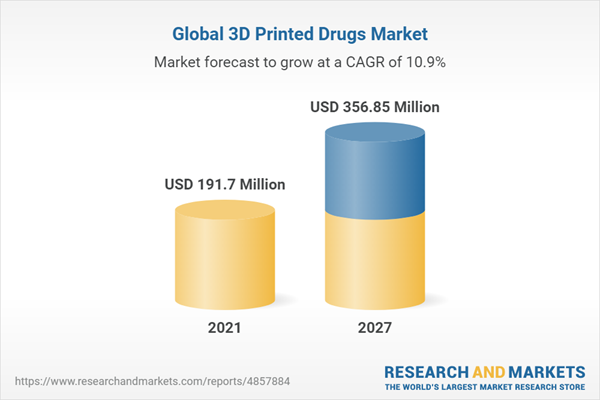The “3D Printed Drugs Market Research Report by Technology (Direct-Write, Fused Deposition Modelling, and Inkjet Printing), End User, Region (Americas, Asia-Pacific, and Europe, Middle East & Africa) – Global Forecast to 2027 – Cumulative Impact of COVID-19” report has been added to ResearchAndMarkets.com’s offering.
The Global 3D Printed Drugs Market size was estimated at USD 191.70 million in 2021, USD 210.55 million in 2022, and is projected to grow at a CAGR 10.91% to reach USD 356.85 million by 2027.
Market Segmentation & Coverage:
This research report categorizes the 3D Printed Drugs to forecast the revenues and analyze the trends in each of the following sub-markets:
- Based on Technology, the market was studied across Direct-Write, Fused Deposition Modelling, Inkjet Printing, Powder Bed Printing, Stereolithography, and Zip Dose.
- Based on End User, the market was studied across Clinics & Hospitals and Research Laboratories.
- Based on Region, the market was studied across Americas, Asia-Pacific, and Europe, Middle East & Africa. The Americas is further studied across Argentina, Brazil, Canada, Mexico, and United States. The United States is further studied across California, Florida, Illinois, New York, Ohio, Pennsylvania, and Texas. The Asia-Pacific is further studied across Australia, China, India, Indonesia, Japan, Malaysia, Philippines, Singapore, South Korea, Taiwan, and Thailand. The Europe, Middle East & Africa is further studied across France, Germany, Italy, Netherlands, Qatar, Russia, Saudi Arabia, South Africa, Spain, United Arab Emirates, and United Kingdom.
Competitive Strategic Window:
The Competitive Strategic Window analyses the competitive landscape in terms of markets, applications, and geographies to help the vendor define an alignment or fit between their capabilities and opportunities for future growth prospects. It describes the optimal or favorable fit for the vendors to adopt successive merger and acquisition strategies, geography expansion, research & development, and new product introduction strategies to execute further business expansion and growth during a forecast period.
FPNV Positioning Matrix:
The FPNV Positioning Matrix evaluates and categorizes the vendors in the 3D Printed Drugs Market based on Business Strategy (Business Growth, Industry Coverage, Financial Viability, and Channel Support) and Product Satisfaction (Value for Money, Ease of Use, Product Features, and Customer Support) that aids businesses in better decision making and understanding the competitive landscape.
Market Share Analysis:
The Market Share Analysis offers the analysis of vendors considering their contribution to the overall market. It provides the idea of its revenue generation into the overall market compared to other vendors in the space. It provides insights into how vendors are performing in terms of revenue generation and customer base compared to others. Knowing market share offers an idea of the size and competitiveness of the vendors for the base year. It reveals the market characteristics in terms of accumulation, fragmentation, dominance, and amalgamation traits.
Market Dynamics
Drivers
- Surge in Demand for Instantaneous Soluble Drugs
- Increasing Use of 3D Printing Technique in the Medical & Healthcare Industries
- Growing Adoption of Personalized Drugs and Production of the Combination Medicine
Restraints
- Antagonistic Effects Related to Drugs
- Usage of 3D Printing to Develop Illegal Drugs
Opportunities
- Constant Technological Developments in 3D Printing Techniques
- Growth Potential in Developing Countries with the Introduction of 3D Printed Drugs
- Rise in Health Care Investment in Emerging Countries
Challenges
- Lack of Government Regulations for 3D Printed Products
Key Topics Covered:
1. Preface
1.1. Objectives of the Study
1.2. Market Segmentation & Coverage
1.3. Years Considered for the Study
1.4. Currency & Pricing
1.5. Language
1.6. Limitations
1.7. Assumptions
1.8. Stakeholders
2. Research Methodology
2.1. Define: Research Objective
2.2. Determine: Research Design
2.3. Prepare: Research Instrument
2.4. Collect: Data Source
2.5. Analyze: Data Interpretation
2.6. Formulate: Data Verification
2.7. Publish: Research Report
2.8. Repeat: Report Update
3. Executive Summary
4. Market Overview
5. Market Insights
6. 3D Printed Drugs Market, by Technology
7. 3D Printed Drugs Market, by End-user
8. Americas 3D Printed Drugs Market
9. Asia-Pacific 3D Printed Drugs Market
10. Europe, Middle East & Africa 3D Printed Drugs Market
11. Competitive Landscape
12. Company Usability Profiles
13. Appendix
Companies Mentioned
- 3D Systems, Inc.
- Anatomics Pty Ltd
- Aprecia Pharmaceuticals, LLC
- BioDuro, LLC
- Biomedical Modeling Inc.
- EnvisionTEC GmbH
- FabRx Ltd.
- General Electric Company
- Materialise NV
- Merck KGaA
- Renishaw PLC
- Siemens AG
- Stratasys Ltd.
- Triastek, Inc.
- Yissum
- Zortrax S.A.
For more information about this report, please visit https://www.researchandmarkets.com/r/f5u049
Subscribe to our Newsletter
3DPresso is a weekly newsletter that links to the most exciting global stories from the 3D printing and additive manufacturing industry.


























